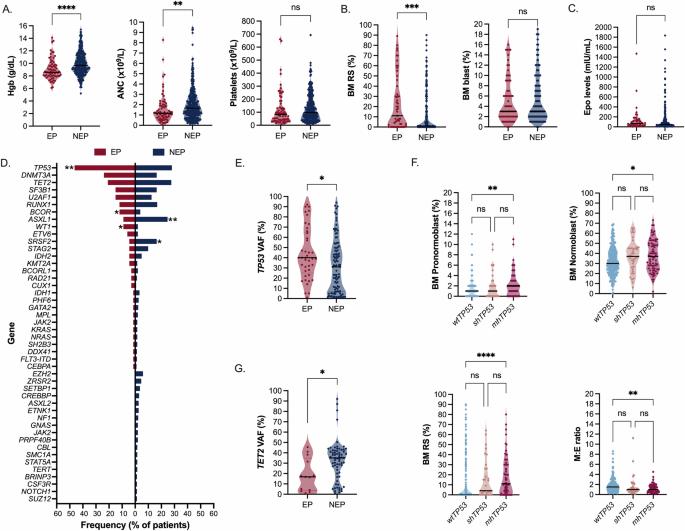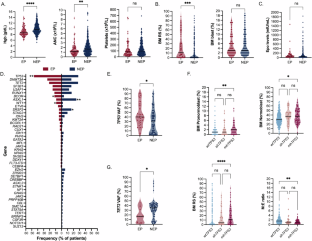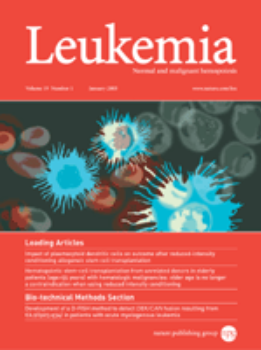以红系为主的骨髓增生异常肿瘤表现出独特的基因组景观,在venetoclaxs为基础的治疗后预后较差
IF 13.4
1区 医学
Q1 HEMATOLOGY
引用次数: 0
摘要
在急性髓性白血病(AML)中,红系分化赋予BCL-XL依赖性和venetoclax耐药性。然而,具有红系优势(EP)的骨髓增生异常肿瘤(MDS)是否具有明显的生物学和药物敏感性尚不清楚,红系骨髓因子≥50%。为了研究这一点,我们评估了一个MDS患者队列(n = 371),发现EP MDS (n = 67, 18%)的特点是TP53(多hit TP53: 36% vs 17%, p = 0.004)、BCOR和WT1高于非EP (NEP) MDS (n = 304, 82%), ASXL1和SRSF2突变频率低。tp53突变型等位基因频率和等位基因状态与红系群体扩增相关。EP MDS以3个遗传亚群为特征,生存期不同(TP53突变体:11.4个月;剪接突变体:未达到;未明确(NOS): 19.5个月,p < 0.001)。在112例HMA-venetoclax治疗的MDS患者中,HMA-venetoclax治疗后EP MDS的白血病转化发生率更高(32% vs 12%, p = 0.040),生存期更差(8.3个月vs未达到,p = 0.041)。11例(33%)患者在venetoclax失败时观察到红系种群扩大。与NEP MDS相比,EP MDS在RNA和蛋白质水平上表达更高的BCL-XL。这些数据支持MDS中红系优势的动态评估,并为这些患者中BCL-XL抑制剂的评估提供了依据。本文章由计算机程序翻译,如有差异,请以英文原文为准。


Erythroid-predominant myelodysplastic neoplasms exhibit a distinct genomic landscape with poor outcomes after venetoclax-based therapy
Erythroid differentiation confers BCL-XL dependence and venetoclax resistance in acute myeloid leukemia (AML). However, whether myelodysplastic neoplasms (MDS) with erythroid predominance (EP), defined by ≥50% erythroid bone marrow elements, have distinct biology and drug sensitivities remains unknown. To study this, we evaluated an MDS patient cohort (n = 371) and showed that EP MDS (n = 67, 18%) are characterized by higher TP53 (multihit TP53: 36% vs 17%, p = 0.004), BCOR and WT1 and lower ASXL1 and SRSF2 mutation frequencies compared to non-EP (NEP) MDS (n = 304, 82%). TP53-mutant variant allele frequencies and allelic states correlated with erythroid population expansions. EP MDS was characterized by 3 genetic subgroups with distinct survival (TP53 mutant: 11.4 months; splicing mutant: not reached; not otherwise specifiable (NOS): 19.5 months, p < 0.001). EP MDS had a higher incidence of leukemic transformation (32% vs 12%, p = 0.040) and worse survival (8.3 months vs not reached, p = 0.041) after HMA-venetoclax therapy among 112 HMA-venetoclax-treated MDS patients. Expansion of erythroid populations during venetoclax failure was observed in 11 (33%) patients. EP MDS had higher BCL-XL expression levels at the RNA and protein levels compared to NEP MDS. These data support the dynamic assessment of erythroid predominance in MDS and warrant evaluation of BCL-XL inhibitors in these patients.
求助全文
通过发布文献求助,成功后即可免费获取论文全文。
去求助
来源期刊

Leukemia
医学-血液学
CiteScore
18.10
自引率
3.50%
发文量
270
审稿时长
3-6 weeks
期刊介绍:
Title: Leukemia
Journal Overview:
Publishes high-quality, peer-reviewed research
Covers all aspects of research and treatment of leukemia and allied diseases
Includes studies of normal hemopoiesis due to comparative relevance
Topics of Interest:
Oncogenes
Growth factors
Stem cells
Leukemia genomics
Cell cycle
Signal transduction
Molecular targets for therapy
And more
Content Types:
Original research articles
Reviews
Letters
Correspondence
Comments elaborating on significant advances and covering topical issues
 求助内容:
求助内容: 应助结果提醒方式:
应助结果提醒方式:


